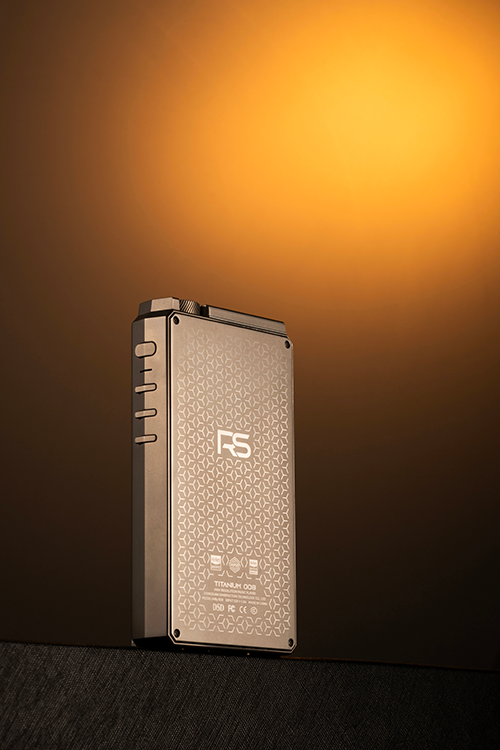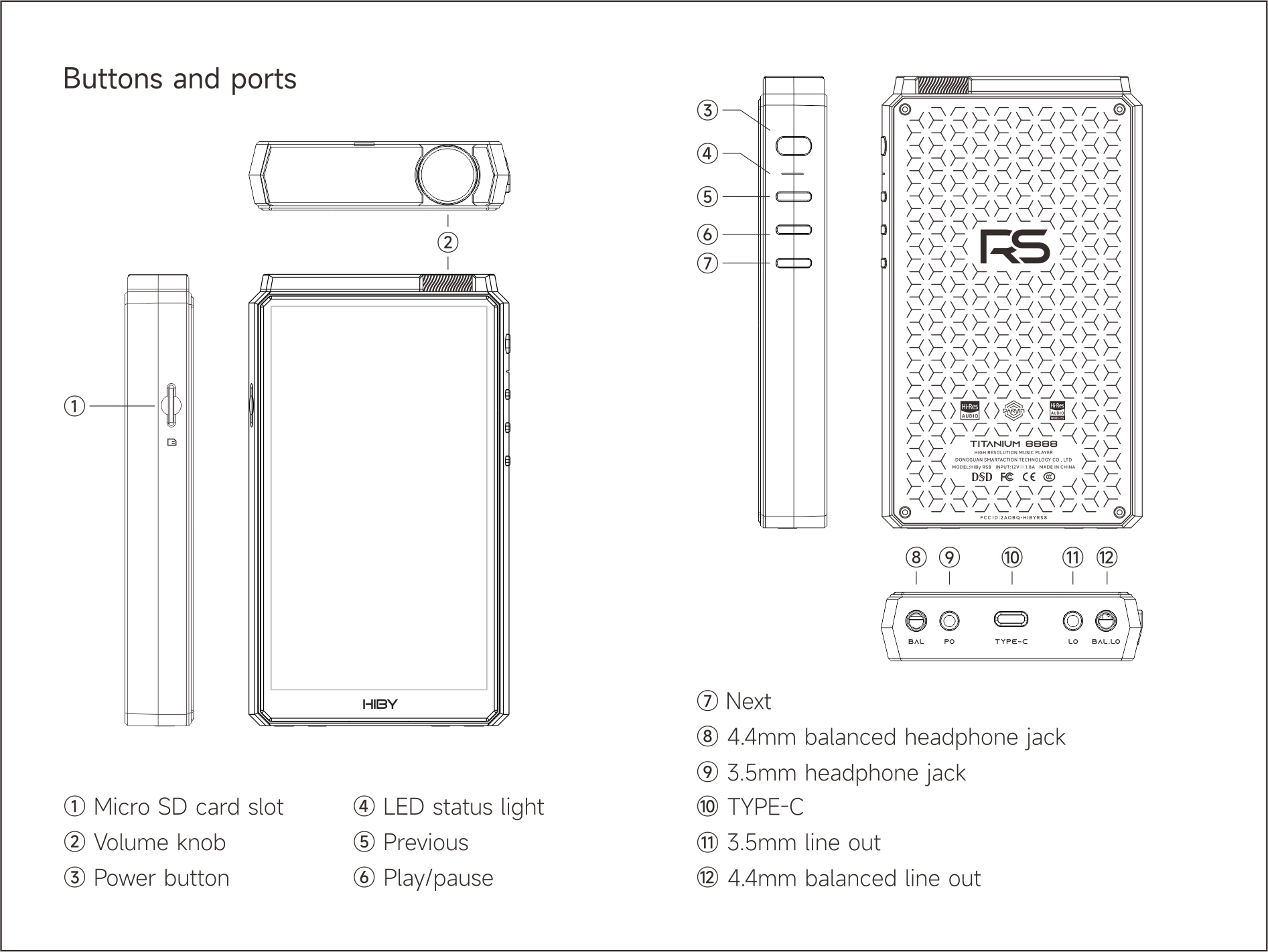HiBy RS8 USER GUIDE

Foreword
Thank you for buying the our Qualcomm-powered high-end R2R portable digital audio player the RS8. To enjoy the most out of your new player as quickly as possible, read through this instruction manual which will introduce you to the functions and usage of the RS8.
Buttons and ports

Essential operations
Power button
1. Power on: hold power button for 2s to power on;
2. If screen is off while device is powered on, press power button or double-tap screen to turn screen on;
3. Power off / restart: a. Press power button to turn screen on, if screen is off; b. press and hold power button until power menu is shown.
4. Lockscreen: when screen is on, press power button to activate lockscreen (turn screen off).
5. Forced restart: Press and hold power button 15s to force restart, if device is e.g. frozen for unknown reason.
Operating system
1.The HiBy RS8 comes preinstalled with Android 12, and its OS operations are in line with a typical Android 12 phone. You may install 3rd party apps using Google Play.
2. It comes preloaded with HiByMusic Professional edition, a music player app designed from the ground up for high fidelity, with strong functionality and intuitive UI;
Audio Output
3.5mm headphone out, 3.5mm line out, 4.4mm headphone out, 4.4mm line out, USB DAC input, USB DAC output, USB coaxial digital output.
Coaxial digital output
The RS8 utilizes its Type-C port for output. Simply plug in the Type-C to RCA coaxial adapter, which comes with your RS8.
RGB LED
The LED on the RS8 power button may be used to indicate the currently playing music format / sample rate:
Red: charging
Yellow: playing--PCM 32-48kHz
Cyan: playing--PCM 64-192kHz
Orange: playing--PCM 352.8kHz and up
White: playing--DSD
Green: --playing MQA
Blue: --playing MQA studio
Purple: --playing MQA Rendering(OFS)
Light blue: No music playing
‘MQA’ or ‘MQA Studio’ indicates that the product is decoding and playing an MQA stream or file, and denotes provenance to ensure that the sound is identical to that of the source material. ‘MQA Studio’ indicates it is playing an MQA Studio file, which has either been approved in the studio by the artist/producer or has been verified by the copyright owner. ‘OFS’ confirms that the product is receiving an MQA stream or file. This delivers the final unfold of the MQA file .
MQA and the Sound Wave Device are registered trade marks of MQA Limited © 2016
Micro SD card
Insert micro SD card into card slot. Max. 2TB supported.
Charging
With battery capacity of 12000mAh, the RS8 supports Power Delivery PD2.0 quick charging; a PD2.0 fast charging charger is recommended (not included), however any USB port may also be used for charging.
USB3.1 over type-C
USB connectivity options
1. File transfer: connect data cable from RS8 to computer. Once connection succeeds, on the RS8, pull down the notification shade, scroll down to where it says “USB for charging”, tap it and change it to “File transfer”, and your RS8 will then show up as a drive on your computer for you to transfer files to and from its internal storage or SD card;
2. USB audio output
Connect the RS8 to a USB DAC via its type C port and audio may be output directly to the USB DAC (function update upcoming);
3. USB DAC IN: USB audio input
a. To use the RS8 as a USB DAC for the computer, connect it to the computer via USB data cable, then pull down the notification shade, scroll down to where it says “USB for charging”, tap it and change it to “audio input”;
b. Also, driver installation on the computer is required. Please download the USB DAC input driver at ____________ and read the included USB DAC usage instruction pdf carefully.
Wireless connectivity
1. Bluetooth 5.0
To connect a Bluetooth device (earphones, speakers, etc.) to the RS8 for the first time, pair it to the RS8 as follows:
a. Pull down notification shade and hold finger on Bluetooth button until the settings page for Bluetooth comes up;
b. Turn on Bluetooth (if not already on);
c. Set your Bluetooth device to pairing mode (consult documentation on your Bluetooth device for how to do this);
d. Tap on “pair new device” on the RS8 to search for new devices to be paired;
e. Tap on the name for your new device to pair and connect with it; successfully paired devices will appear on the list of “paired devices”.
2. WiFi
The RS8 supports both 2.4GHz and 5GHz WiFi, which may be used to connect the RS8 to the Internet for streaming music, as well as the various WiFi functions of HiByMusic such as WiFi music transfer, HiByLink, DLNA music access etc.
a. Pull down notification shade and hold finger on WiFi button until settings page for WiFi comes up;
b. Turn on WiFi (if not already on);
c. Tap on the name of your WiFi network.
d. Enter the password for your WiFi network and tap Connect.
Firmware update
OTA online update
1. updating automatically via WiFi is recommended.
2. The RS8 will automatically detect updates and prompt about the update in the notification shade if an update is found;
3. You may also go to Settings->System->System Updates to manually check for and download updates;
4. Install updates after they are downloaded to update your device. Please make sure device is well charged before update and do not try to operate the device during the update.
DTA (Direct Transport Audio) Architecture
1. The HiByMusic DTA Architecture circumvents Android sample rate conversion on a system level to reliably product completely lossless audio streams on Android;
2. The preinstalled HiByMusic app may directly output DSD512, PCM768kHz / 32bit and MQA at 16x unfold; DTA provides the groundwork for all 3rd party apps to output at these same formats and rates but certain 3rd party apps may not be able to do so, owing to limitations inherent in the app (e.g. assuming the system is unable to output at those formats / rates and resampling internally before handing out audio to system).